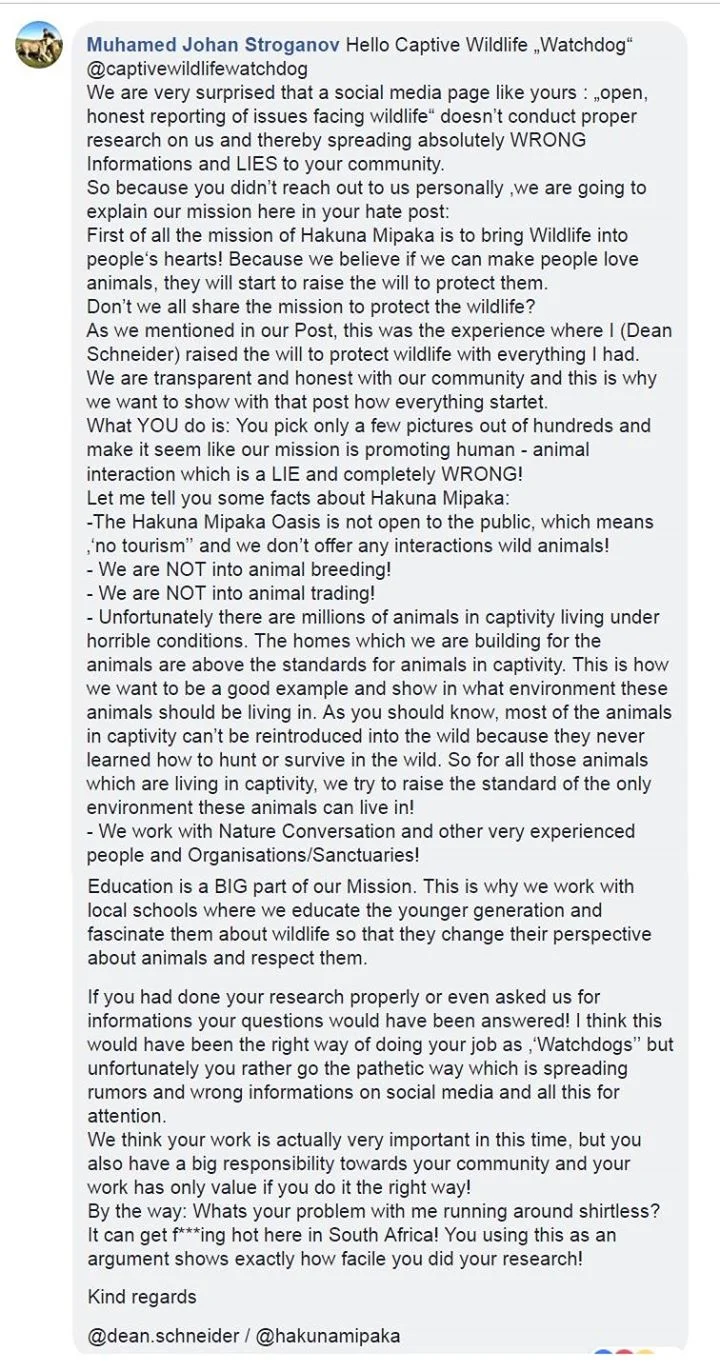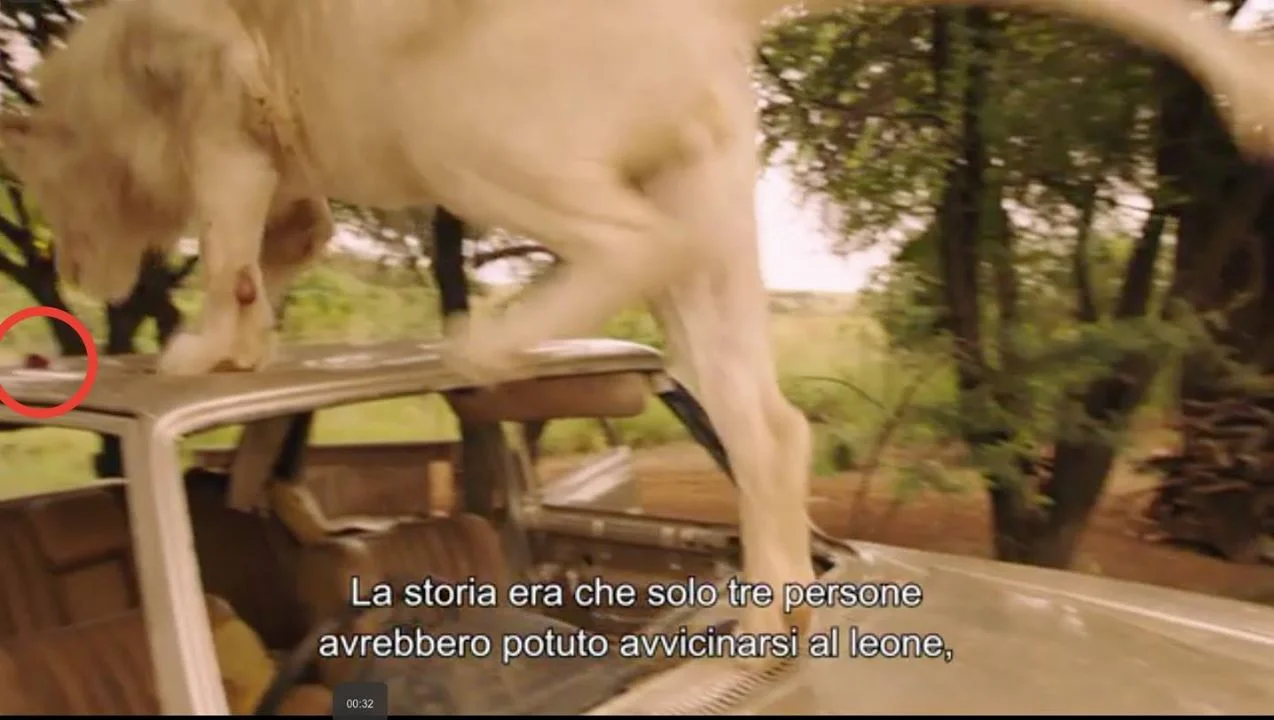We received a quick reply, which gloriously showcases how animal exploiters like Doc Antle, and those who work for him, abuse the laws meant to protect others in order to stop entities like CWW from reporting on, and educating the public about, their lies and damaging behavior.
This is the reply we received from Nicholas Balestracci (copied and pasted verbatim below, rather than shown in a screenshot, because, well, Mr. Balestracci’s accusations over screenshots is why this post is being made)
To whom it may concern,
I am the official photographer for the Myrtle Beach Safari. All of the photos taken AT the Myrtle Beach Safari are produced by me or my team. I do not have your “post” in a screenshot so I can not point out specifically. However almost every screenshot your post contained of our (Myrtle Beach Safari, Doc Antle, etc.) social media posts and other photos you obtained through the internet are taken by me or produced by my team. I am either tagged in those photos/posts or have posted the photo myself in some format.
If you continue to post ANY of my photographs, videos, etc. then I will continue to report.
I do not want my photos used for the reason you are using them.
Please DO NOT respond or contact me again for any reason.
Thank you,
Mr. Balestracci
Anyone with even minimal legal knowledge will already be laughing at the content of this reply, but let’s go ahead and unpack this response in detail.
“I am the official photographer for the Myrtle Beach Safari. All of the photos taken AT the Myrtle Beach Safari are produced by me or my team.”
Whoooo-boy. Okay.
Firstly, Nicholas Balestracci, as per the “About” section of his own Facebook page, has been the “official photographer for the Myrtle Beach Safari” since early April 2018. Yep, the guy who filed a DMCA complaint for “a photo” from among 45 photos, and who claimed that “All” photos “taken AT the Myrtle Beach Safari” are copyrighted by him personally, has only been taking photos at MBS for 10 months, according to his own timeline.
Secondly, the only visual indication of where any of the photos we utilized might have been taken is the “Location” shown on the various posts, something that can be added and edited multiple times, and does not have any legal obligation to be the actual location depicted in the post. In addition, there were a minimum of 45 photos used in our post, many of which were not labeled as MBS, and some of which were taken at a different facility located on an entirely separate continent.
Third, no, not all the photos taken “AT” MBS are produced by Mr. Balestracci, or his team. As just mentioned, Mr. Balestracci has been employed at MBS for 10 months (per his own biography)–not even one calendar year–so again, no, not every photo taken “AT” MBS was produced by Mr. Balestracci or his team. Prior to April 2018 Mr. Balestracci was not even employed at MBS to be taking photos there.
Fourth, just for readers’ reference the Instagram pages listed below, are just the ones we know about, which are directly associated with MBS, and for which Mr. Balestracci is essentially claiming to own copyrights for all visible content within.
@Rarespeciesfund
@Docantle
@Kodyantle
@tawny.thetiger
@Myrtlebeachsafari
@Tiger411
@china.york
@TheRealTarzann
@gibbonmom
@mokshabybee_tigers
@zooinfo411
@tigershakti
Furthermore, the two sites listed below have shared videos taken at MBS, without referencing or crediting Balestracci, yet Balestracci seems to have no issue with these “copyright infringements”.
@whathapndng
@worldstar
He even promoted one of them on his own Facebook page, on January 26th, linking to it, and cheerfully announcing that the video he took (but for which he is not credited) made World Star! The video, which shows The Real Tarzann playing with a baboon, has garnered over half a million views.
Guess that indignant copyright rage he had going on is situational.
“I do not have your “post” in a screenshot so I can not point out specifically.”
Wait, what?
We’ve by now established that DMCA complaints heavily favor the complainant. But even so, lodging a DMCA complaint is not *quite* as simple as writing a sentence or two to the host website.
In order to lodge a DMCA complaint, you have to (or you’re *supposed to*) provide detailed information about where the work appears with your permission, include original copies, where it’s being infringed upon, contact details, etc.
Facebook uses an online form for DMCA complaints–though they encourage users to contact the person they feel is infringing on their copyright before filing a DMCA complaint, in order to exhaust all venues of settlement before engaging in a DMCA complaint. Mr. Balestracci opted to skip that step and go straight to filing against CWW. The requirements for filing a DMCA complaint with Facebook’s online form has been directly copied and pasted here:
Your complete contact information (full name, mailing address and phone number).*
A description of the copyrighted work that you claim has been infringed.
A description of the content on our site that you claim infringes your copyright.
Information reasonably sufficient to permit us to locate the material on our site. The easiest way to do this is by providing web addresses (URLs) leading directly to the allegedly infringing content.
A declaration that:
You have a good faith belief that use of the copyrighted content described above, in the manner you have complained of, is not authorized by the copyright owner, its agent, or the law.
The information in your notice is accurate.
Under penalty of perjury, you are the owner or authorized to act on behalf of the owner of an exclusive copyright that is allegedly infringed.
Your electronic signature or physical signature.
*Please note that we regularly provide your name, contact information and the contents of your report to the person who posted the content you are reporting. If you are an authorized representative submitting a report, we provide the name of the organization or client that owns the right in question. You may wish to provide a professional or business email address for this reason.
So Mr. Balestracci took the time to provide all of that information and lodge a DMCA complaint, but in his email reply to CWW he claimed that because he didn’t have a screenshot directly in front of him, he couldn’t tell us which photo in our post was copyrighted by him.
But it gets even better.
“However almost every screenshot your post contained of our (Myrtle Beach Safari, Doc Antle, etc.) social media posts and other photos you obtained through the internet are taken by me or produced by my team. I am either tagged in those photos/posts or have posted the photo myself in some format.”
Firstly, “almost every screenshot” was not cited on the DMCA complaint which Mr. Balestracci filed against CWW. “A photo” was listed.
Secondly, “almost” isn’t even a legally binding term, and “almost” is not the same as “a”.
Thirdly, as we’ve established, no, all photos taken “of” MBS are not, in fact, taken by you, or produced by your team. As per the biography listed on your own photography website, you are currently twenty-two years old. So, for example, this photo of Kody Antle as a three or four year old was not taken by you, nor your team, as you weren’t even born in the mid-80s when that photo was taken. And if Kody Antle put up a photograph taken when he was a child, on his own Instagram page, you don’t get to claim the copyright to it.
Fourth, nope, sorry honey, you aren’t tagged in most of the photos used, and as we just mentioned regarding time frame, you did not post them in “some format” from all the various pages either attributed to MBS or Instagram profiles which belong to the thousands of guests who have visited MBS. Nor are you tagged or credited in all of the 11,000+ Instagram search results under #rarespeciesfund.
POP QUIZ FOR READERS!
Mr. Balestracci stated in his letter that he was the “official photographer” for Myrtle Beach Safari and that our “post contained of our (Myrtle Beach Safari, Doc Antle, etc.) social media posts” so does that mean the DMCA complaint was made on behalf of Myrtle Beach Safaris, and that MBS’s copyrights were being infringed upon by our use?
How closely have you been reading?
Answer:
NOPE!
This DMCA complaint was NOT lodged on behalf of MBS, and therefore the copyrights in question are NOT copyrights held by MBS, or Doc Antle, even though Mr. Balestracci’s email reply clearly implies that all photos taken at MBS or posted on accounts run by MBS (including Doc Antle’s) are copyrighted by Mr. Balestracci himself.
Confused?
Details matter.
On the formal DMCA complaint Facebook sent us, the Rights Owner was listed as Nicholas Balestracci. Contact for Mr. Balestracci (which we aren’t going to publish) was the email address associated with Balestracci’s personal photography business website, Nick B Photos.
Facebook’s online form for DMCA complaints specifies “If you are an authorized representative submitting a report, we provide the name of the organization or client that owns the right in question.” But within the DMCA complaint lodged against CWW, the only entity listed is Nicholas Balestracci. And the only email provided was directly to Nicholas Balestracci’s photography company, Nick B Photos.
Myrtle Beach Safaris was not named.
Doc Antle was not named.
No email for Myrtle Beach Safari was provided.
No email for Doc Antle was provided.
Therefore the Mr. Balestracci lodged a DMCA complaint on behalf of himself, and his personal photography company, not Myrtle Beach Safari or Doc Antle, and any copyrights owned by MBS are completely irrelevant to this entire situation.
Basically, everything Mr. Balestracci is insinuating and claiming in his email response to CWW, all of his assertions that any photo taken from MBS social media profiles, and any photo taken “AT” MBS, are owned by him and his “team”, are completely invalid.
Only a photo taken by Mr. Balestracci himself, and to which Mr. Balestracci owns the exclusive copyrights, is even eligible to be the “A photo” he named in his DMCA complaint. And none of the photos utilized in CWW’s Note were taken from Mr. Balestracci’s photography website.
Having permission to create and disseminate media on the behalf of an employer does not equate to owning the exclusive copyrights to that media. Mr. Balestracci, by his own wording, produces content (photos, videos, etc.) as an employee of T.I.G.E.R.S. Myrtle Beach Safaris (full name of the institute) which was founded by, and is directed by, and owned by Mahamayavi Bhagavan “Doc” Antle. Therefore Doc Antle would actually retain sole proprietorship to the content created for all of his companies. Mr. Balestracci might well have rights to utilize certain photos he took or content he created, for his own purposes, but his rights would be second to those of his employer, Doc Antle and T.I.G.E.R.S. Myrtle Beach Safari.
If that were case it would actually eliminate every photo in our post from the purview of the DMCA complaint that Mr. Balestracci filed against CWW.
Now, here’s the part that will cause anyone who supports what CWW is doing, and what we stand for, to spit coffee and curse.
None of what we just explained matters as far as DMCA complaints against us go.
Facebook’d automated system for fielding DMCA complaints doesn’t vet the complaints. It doesn’t research them. It doesn’t question them.
It receives a complaint, and it removes the content listed therein. Period.
Facebook automatically removes content named in DMCA complaints even if the complaint is false, and the complainant is intentionally lodging the complaint in order to have an article they don’t agree with removed.
Yes, CWW could send a counter-notice, to the DMCA complaint lodged against us, but doing so means we would have to, for lack of a better description, invite Mr. Balestracci to sue us, if he chooses to continue claiming we infringed on his copyrights (which we did not) as well as provide him with court jurisdiction information so that he can readily file a suit against us if he chooses to. Aside from the repugnance of asking a victim to help their accuser further attack them, it’s simply not worth our effort pursue a counter-notice. Even if Mr. Balestracci folded (doubtful, considering the arrogance and self-importance involved with him attempting to claim copyright ownership of over 11,000 photos pertaining to MBS, by whom he’s been employed for only 10 months) and he gave consent for our Note to be reposted, it would take an average of 14 business days for Facebook to repost our content. It’s easier just to repost it ourselves, and then take the opportunity to give our readers a window into what happened.
And filing a counter-notice would probably be pointless anyway, from the standpoint that Mr. Balestracci made it quite clear in his email response to us that he would continue to file DMCA complaints for ANY photo, video or other media that we use which shows Myrtle Beach Safaris, which he continued to refer to with the term “my”.
“If you continue to post ANY of my photographs, videos, etc. then I will continue to report.”
Since Facebook’s automated DMCA complaint system does not verify the complaints lodged, it will simply continue to remove our content every time Mr. Balestracci files a DMCA complaint, even though he doesn’t actually own the copyrights he’s claiming we’re infringing upon. Yes, this is illegal of him, but because of the manner in which DMCA complaints are handled, the only way someone like Mr. Balestracci will be held legally accountable for his behavior is if someone like CWW expends the money and effort to pursue legal action against him. And the fact is, he just isn’t worth the bother. In the grand scheme of things, he’s just another spoiled, self-important young man who thinks he can rearrange the universe to suite himself.
Mr. Balestracci explained his own actions in filing the DMCA complaint against CWW in his email response to us, and his reasoning unsurprisingly has nothing to do with copyrights, or our legal right to use media of Myrtle Beach Safari through the Fair Use Doctrine.
“I do not want my photos used for the reason you are using them.”
This entire chain of events started with a young man posting incorrect facts, misleading information, and ignorant content on his Instagram post because he refused “to listen to leadership he didn’t respect” and it’s arrived at its current state because another young man doesn’t “want my photos used for the reason you are using them.”
This is what CWW is fighting against. A public who not only doesn’t want to know the truth, but also doesn’t want their own facts handed back to them in support of the truth they’re trying to deny. Mr. Balestracci doesn’t have to “want” us to use media from MBS’s social media accounts to show that Doc Antle’s Rare Species Fund involves cub petting and pay-to-play schemes, but he legally can’t stop us from utilizing media associated with MBS through Fair Use Doctrine, when we’re reporting the truth about MBS. Never mind the fact that he’s asserting that every photo on any site that portrays Doc Antle’s Myrtle Beach Safari is exclusively his property.
Unfortunately, since it was created in 1998, the DMCA has only become more, and more of a quagmire, especially with the introduction of, and poorly overseen, systems of automated complaint and take-down used by the majority of sharing websites like Facebook. Add to that the fact that even those who file counter-notices, and bring lawsuits agains those who have falsely accused them of infringement get little or no justice, even with new laws which are supposed to curb false DMCA complaints, and it’s a shitshow, at best. Some even argue that the DMCA is unconstitutional on its face because it interferes with free speech. The damage to the First Amendment, and the destruction of Fair Use Doctrine caused by the DMCA has been studied by Law entities, and covered by multiple scholarly sites. The abuse of the DMCA enjoyed by entities who lodge DMCA complaints simply to get content they don’t like removed, has been widely and repeatedly discussed.
The truth will out in the end, though. It always does.
CWW is not going to stop posting about Myrtle Beach Safari, or Doc Antle, or the lies, abuse, and misleading fake information they sell to the ignorant public, simply because a kid with a camera gets his nose out of joint and throws a temper tantrum. At the end of the day, Mr. Nicholas Balestracci is the one who comes out looking like an ignorant ass, attempting to claim copyright ownership of any content posted on more than a dozen social media accounts, of any age, at any time, along with more than 11,000 Instagram search results.
CWW is going to keep doing what we do, while exploiters like Mr. Balestracci are going to keep doing everything they can, legal or not, to try and stop us. Let them try. We’re not the ones breaking the law here.
Headline Image attributed to Pat_S on TammyBruce.com




















































































































